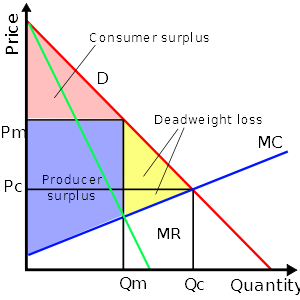In which the author clears the cobwebs off his knowledge of economics, and puts it to use, ignoring its creaking and groaning.
I was recently browsing the Dutch Piratenpartij (Pirate Party) website, and came across this (somewhat old) article. It is entitled “Kom niet aan het recht om te delen!”, roughly translating as “Don’t infringe upon the right to share!”. It discusses the philosophy of filesharing.
The very first argument presented attempts to use economics to prove a point, providing a supply and demand diagram (labelled in English). I got a bit confused at this point, and had to reread the argument several times: I eventually convinced myself1 that the diagram didn’t make sense in the context it was used! The article was talking about monopoly markets, while the diagram was talking about price ceilings! Both can be argued to cause deadweight loss (mentioned in the article) – along with just about anything that takes the market away from free market equilibrium. See later for more information about deadweight loss…
Not trusting my own conclusion, I went to Wikipedia to find the ‘correct’ diagram. Indeed, I found it here. The diagram made much more sense. Mainly because it actually fit the context, secondly because it used straight lines instead of curves. The latter is important because straight lines help you to remember that the whole construction is an idealisation…
See is the diagram below (copyright and licensing information here2)

Source: http://en.wikipedia.org/wiki/File:Monopoly-surpluses.svg; CC BY-SA 3.0 AND/OR CC BY 2.5 AND/OR GFDL >=v1.
I’m still a bit confused about the green line…
I will now offer a quick explanation that will help if your economics knowledge creaks like mine. If you are an economist you may get bored and/or horrified.
In a free market, the market forces a quantity Qc of items to be exchanged at a price Pc. This quantity and price maximises the surplus of both producers and consumers.
For the consumers, surplus is the total ‘perceived’ value of the goods minus the total cost they paid to the producers. For the producers, it’s the total value received from the consumers minus the actual total manufacturing costs of the goods. Roughly speaking.
In a monopoly market, the seller sets the price, so as to maximise his/her/the company’s own surplus, and Qc and Pc become Qm and Pm respectively.
What happens to the total surplus? Some of the lost consumer surplus is picked up by the producer. Some people, however, can’t pay for the good at the new, higher price. So they simply don’t buy it!
The consumers who have to exit the market lose their surplus, and the company loses the surplus it could have had from selling to these customers (but makes up for it elsewhere, otherwise this new price wouldn’t be profitable!)
So the TOTAL surplus (i.e. the surplus of the whole society) goes down. This is called deadweight loss, because this surplus is just lost, not shuffled around
A company can make more profit by trying to get the consumers back. They can do this by offering lower prices to those who are willing to pay less.
Like that sounds, it’s not easy to do properly! However, cut-out coupons are one cunning attempt. (People who aren’t able to pay the full price might instead be willing to spend time cutting out coupons). This also restores (some of) the lost consumer-side surplus. Of course, the coupon system is neither totally efficient nor universally applicable.
As the article mentioned at the beginning argues, software piracy can be argued to reduce the part of the deadweight loss on the consumer side. I won’t go any more into this, as this article is way too long already! But I think you can see how the argument might go…
Footnotes:
1 I thought at first that I might simply be not reading the Dutch correctly.
2It took me almost as long to figure out the legal details of displaying the image here as it did to write this article. I still am not clear whether all the licences apply or whether you can choose. Worst case it should be OK to use here. Correct me if I’m wrong.

